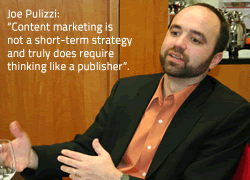
Joe Pulizzi originally defined content marketing as “a marketing technique of creating and distributing relevant and valuable content to attract, acquire, and engage a clearly defined and understood target audience – with the objective of driving profitable customer action”.
Since then the definition was finetuned a few times but it’s clear that content marketing plays a crucial role in an integrated and customer-centric marketing approach. Many people focus on the content as such, leading to a content-centric attitude. However, content marketing is first and foremost about driving action across several touchpoints in the customer life cycle and buying journey. The use of content for marketing purposes is by definition integrated and connected. The overall context in which it is used matters a lot.
The end goal of content marketing is raising profit, directly or indirectly. Intermediary goals, such as engagement, word of mouth and social sharing, are ways to ultimately serve these goals in a connected world.
By focusing on the relevance and context of different content objects in each step of the buying journey, businesses can attract, engage, nurture and convert people by providing valuable content. At the same time, it helps them achieve their business goals and turn visitors into leads and customer in the largest possible sense.
Some key facts to remember about content marketing
- Content marketing is not just about producing content. It is integrated in an overall strategy, including conversion marketing, SEO, social, email lead management, marketing automation, etc.
- Content must be contextually relevant to your prospective clients and customers, taking their demographic, behavioral, transactional and other data into account.
- Define your buying personas or content marketing personas (normally the same) and target audiences.
- Content, as well as the timing, channels and format to provide it, depend on customer needs, social context, predefined stages and business goals.
- Content should be consistent and used as a means to increase conversion by focusing both on informational and emotional needs.
- Define a content marketing grid and map what various profiles need in relationship with your business goals and their journey. Use it to analyze what content you need.
- Use different content marketing related metrics depending on the role of the content in the different stages of the buying cycle or customer journey. They are not your goal as such but important to be able to measure your goal.
- It is the task of marketers to find the right content to offer in terms of the customer and his digital footprints. Listening, analyzing and acting is key.
- People, processes, outcomes, cross-divisional collaboration and flows/scenarios are essential to succeed.

